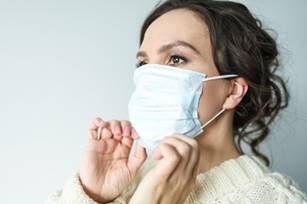
CATER Mask
Decisions
December 11, 2020
Here is the Largest Emergency
Room
SGS Provides Guide to Public
Mask Regulations
CATER Mask Requirements
Qualitative Fit Testing for
Every Facility
French Barrier Mask Requirements
were Established in April
NC State Working on Procedures
for Cloth Mask Testing
Washington Post Funds Infra-Red
Camera Analysis of Virus
Exhalation
_____________________________________________________________________________________
Here is the Largest Emergency
Room

The grim news is that there are
millions of people on this
planet capable of transmitting
COVID at this moment. Even
though these people are
dispersed around the globe the
risks of infection are as high
as you would normally experience
in a hospital emergency room.
Companies such as Mann +Hummel
and Daikin-AAF are viewing the
world as one large cleanroom
where ambient air flow and
cleanliness need to be managed.
CATER masks are an important
product in a successful battle.
If you suggested to a
semiconductor cleanroom operator
that a 30% efficient mask would
be better than nothing his reply
would be maybe so, but you are
not going to enter his
cleanroom. If the most efficient
masks are needed to reduce chip
losses what about the value of
human losses?
Biopharmaceuticals are produced
in cleanrooms where the ambient
particulate levels of 500,000
particles/ft3
0.3 microns and larger
are reduced to just 10
particles. With the advent of
closed
systems the worker is no
longer in the space but
nevertheless room cleanliness is
kept at 10,000/ft3.
When most of the world’s
population is vaccinated it will
be the equivalent of closed
operations in a
biopharmaceutical
facility. But there will
be other viruses, air
pollutants, allergens,
wildfires, and air contaminants.
Therefore a relatively high
level of HVAC filtration and use
of efficient masks will continue
for the foreseeable future.
SGS Provides Guide to Public
Mask Regulations
As more individuals turn to
reusable face masks, most often
‘do-it-yourself’ (DIY) made from
fabric, countries have begun to
develop regulations, standards,
and guidelines to ensure their
proficiency.
As a fabric mask is directly in
contact with skin for
potentially long periods of
time, relevant restricted
substance and biocompatibility
testing are highly encouraged.
Also, the ear loops have to be
securely attached to a reusable
mask for the duration of its
expected lifetime.
Relevant performance testing for
fabric face masks include:
-
Barrier
performance
-
Breathing
resistance
-
Functional
testing
-
Colorfastness
testing
-
Ear loop
attachment
strength
-
Restricted
substances
SGS earlier this year prepared
listing of the specifications in
various countries. It will need
to be updated but is a good
starting point.
Of all the specifications,
‘barrier performance’ is the
most crucial when it comes to
reusable fabric masks. Most
locations have adopted
particulate filtration
efficiency (PFE) as the major
barrier performance, while
bacterial filtration efficiency
(BFE) is specified in Spain and
Portugal.
Summarized below are the barrier
performance
regulations/standards/guidelines
in some markets:
|
COUNTRY |
TYPE OF SPECIFICATION |
REGIONAL REGULATION/ STANDARD/GUIDELINES |
BARRIER PERFOR |
TEST METHOD |
REQUIREMENT |
|
France |
Regulation |
French Cross Ministries Note (NOTE d’INFORMATION du 29 mars 2020 Mise a jour le 26 avril) Mandatory requirement in France |
PFE |
Dissolved gas analysis (DGA) method Annex 2 or equivalent |
Particles size: 3 microns: |
|
Guidelines |
AFNOR Spec S76-001 v1.1 |
PFE |
DGA method Annex 2 or equivalent |
3 microns particles: |
|
|
Spain |
National standard |
UNE 0065 |
BFE |
EN 14683:2019 + AC: 2019 Clause B |
≥ 90% |
|
Belgium |
National Standard |
NBN/DTD S 65-001:2020 |
PFE |
EN 13274-7:2019 |
≥ 70% |
|
BFE |
EN 14683:2019+AC:2019 Annex B |
≥ 70% |
|||
|
Ireland |
National standard |
SWiFT 19:2020 |
BFE |
EN 14683:2019+AC:2019 Annex B |
≥ 70% |
|
Portugal |
Portugal specifications |
Masks intended for use under COVID-19 technical specifications 1 |
PFE |
EN 13274-7:2019 |
Level 2: ≥ 90% |
|
BFE |
EN 14683:2019+AC:2019 Annex B |
Level 2: ≥ 90% |
|||
|
Switzerland |
Recommendation by task force |
Swiss National COVID-19 Science Task Force |
PFE |
Particle size: 1μm |
≥ 70% |
|
Germany |
Recommendation |
BfArM recommendations |
- |
- |
Attention on marking and labeling issue |
|
United Kingdom |
Recommendation |
BSI guide to masks and face coverings for use in the UK during the COVID-19 pandemic |
PFE |
EN 13274-7:2019 |
Requirement to be determined by the Cabinet Office/Department for Business, Energy and Industrial Strategy (BEIS) |
|
EU countries |
Reference document from the CEN Members |
CEN Workshop Agreement |
PFE |
EN 13274-7:2019 |
Particles size: 3 microns |
|
United States |
Recommendation by industry |
General Purpose Woven Face Coverings – Guidance and Considerations |
*Not Applicable |
ASTM F2299 or technical equivalent, with modified micron size |
3 micron particles >= 70% filtration efficiency as minimal |
|
China |
Association standard |
T/CSTM 00387-2020 |
PFE |
GB/T 38413-2019 |
PM 2.5 daily reusable protective mask |
|
South Africa |
Recommendation |
Recommended Guidelines |
PFE |
EN 13274-7:2019 |
Particle size: 5 microns |
SGS offers testing and
consultation services for
interested parties on fabric
masks to test if the product
performance satisfies relevant
regional specifications and
requirements, and shares
information on export/import
procedures.
The network is capable of
providing mask testing and
consultation services in the
following locations:
-
Hong Kong, China
-
Shanghai, China
-
Cestas, France
-
Appleton, USA
-
Fairfield, USA
-
Grasslake, USA
CATER Mask Requirements
Here are some of the parameters
which are needed to create a
good CATER mask
Comfortable:
Suitable constituent materials
safe for respirators (including
textiles, filter media, inks and
dyes, packaging)
Designed to facilitate correct
positioning on the user and
remain in place
Adequate adjustment options,
such as no charge wrong size
replacement, head strap
accessory and noseband
No restriction of the user's
field of vision
Easy breathing established by
inhalation and exhalation
resistance tests
Attractiveness:
Aesthetics of product appearance
on face
Designs and colors
Encourages compliance in mask
wearing
Encourages mask use in all
environments
Tight-Fitting:
Manufacturer to supply correct
donning, doffing, fitting, and
noseband instructions
Product support to ensure
correct size
Practical performance testing on
test subjects to determine
leakage under normal activities
Efficient:
3rd Party Testing on all design
and engineering changes
NaCl Particle Filtering
Efficiency at mean diameter
.3-microns
Continuous flow rate at 85
L/min
Quality plan in manufacturing to
include Quality Checkpoints and
Inbound Quality Inspection
Clear communications for
consumer on reason for various
particle size testing
Minimizes reduction in speech
communication
Reusable:
Components designed to maximize
number of wearings
Clear instructions on cleaning
and care which minimize
efficiency reduction
Qualitative Fit Testing for
Every Facility
Every meat processor, industrial
plant, corporate office
building, restaurant, and other
entity in need of tight fitting
masks should provide CATER masks
for their employees and assure
that the right size mask is
available for each employee and
that they are wearing them
properly. Since leakage is just
as important as mask media
efficiency we recommend that a
firm such as Examinetics come to
each facility and conduct
qualitative fit tests on each
employee after they have
received the right tight fitting
mask.

Qualitative fit testing is a
pass/fail method used on
half-masks that relies on senses
- such as taste and smell - to
detect air leakage from the
respirator. The half masks being
tested must have an overall fit
factor (mask particle
concentration divided by the
ambient particle concentration)
of 100 or less. The test relies
on a harmless, yet
bitter-tasting chemical called
Bitrex, which will determine
whether you pass. Rather than
measuring the amount of leakage
into the facepiece, the
qualitative fit test determines
whether the facepiece is in
working order. Unfortunately, if
you taste a bitter substance, it
is a fail.
For those who cannot detect
bitter taste, they offer
saccharin, an artificial
sweetener, as a replacement.
· Bitrex: a chemical that leaves
a bitter taste in your mouth
· Saccharin: a chemical that
leaves a sweet taste in your
mouth
There may need to be some
adaptation for masks such as
used in non-medical facilities.
For example, the amount of
chemicals could be diluted so
that the pass fail test
approximates what would be
achieved in a mask with a 80%
net efficiency.
Examinetics has a fleet of more
than 130 mobile units that come
to the facility. The fleet
provides flexible scheduling
options and a centralized
solution for occupational health
needs.
The activity could be
coordinated with mask suppliers
or with larger mask retailers. Walmart
could offer a program where you
buy the mask and are tested in
their parking lots.
French Barrier Mask Requirements
were Established in April
Yesterday we reported on the new
update to the French standards
to take into account masks with
a clear area around the mouth.
Here is a good summary by
SGS of the basic standards which
were published in April.
The French association, AFNOR,
has released AFNOR SPEC S76-001
“Masques barrières" or “Barrier
Masks” (in English), a standard
that establishes minimum
requirements for non-medical
general purpose masks.

The French standards
association, AFNOR, has released
AFNOR SPEC S76-001 “Masques
barrières" or “Barrier Masks”
(in English), a guideline that
establishes minimum requirements
for general purpose
(non-medical) woven masks.
AFNOR Group designs and deploys
solutions based on voluntary
standards around the world. The
Group serves the general
interest in its standardization
activities and provides services
in such competitive sectors as
training, professional and
technical information and
intelligence, assessment, and
certification.
AFNOR sponsored a group of
industry experts along with
members of standardization
commissions for personal
protective equipment (PPE) and
for textiles. The guideline
provides the minimum
requirements, methods of
testing, fabrication and use of
general-purpose woven barrier
masks.
Per the guideline, a woven
“barrier mask” is intended for
use by healthy people not
exhibiting clinical symptoms of
viral infection and not being in
contact with people with such
symptoms. Such masks do not
provide the same medical
benefits or protection than
those for which EN 14683
(medical masks) or EN 149
(respiratory protective devices)
are applicable.
AFNOR SPEC S76-001 masks are not
medical devices, and thus are
not within the scope of Medical
Device Directive 93/42/EEC or
Medical Device Regulation (EU)
2017/745. Neither are they PPE,
and thus do not fall under the
scope of Regulation (EU)
2016/425.
In an industry landscape
typically dominated by medical
and protective masks/respirator
performance standards, SPEC
S76-001 becomes one of the few
standards that addresses general
purposes woven masks. Viewed as
critical to address mask
shortages; woven masks allow for
reusability while their
construction leverages the much
larger textile industry instead
relying solely on nonwovens.
Furthermore, this allows medical
masks to be prioritized to
healthcare workers and patients.
As COVID-19 continues to
develop, Governments have been
increasingly recommending
citizens to wear masks in
public, protecting both
themselves and workers providing
essential services to the
public. This has led to a sharp
increase in the demand for
general purposes masks.
Manufacturers seeking to meet
this demand can now look to SPEC
S76-001 to ensure their masks
meet an acceptable level of
performance and safety.
AFNOR SPEC S76-001 requirements
include, but not limited to:
-
Visual
Inspection and
Dimensions
-
Packaging and
Materials
-
Marking and
Labelling
-
Cleaning and
Drying
-
Breathing
Resistance (Breathability),
and
-
Penetration
Resistance
(Particulate
Filtration)
A critical component to the
guideline is washing and drying,
as the manufacturer must decide:
-
Mask washing
instructions
-
Duration of use
before mask
should be washed
(4 hours
maximum)
-
The maximum
number of washes
before mask
should be
disposed
To validate efficacy, the
penetration and breathability
tests are to be performed after
the maximum number of washes.
Product must meet minimum
specified penetration and
breathability requirements. The
penetration of the barrier mask
shall have either a filtering
capacity of 70% for solid
particles or for liquid
particles (droplets) with a
particle size spectrum extending
up to 3 μm.
On 29 of March 2020 French
Government issued a cross
ministry (Labour, Health,
Finance) instruction defining
two categories of masks “Usage
Non Sanitaire” (Non-medical
purpose): UNS 1 and UNS 2.
-
Cat I – UNS 1:
for workers who
have frequent
and regular
contact with the
public such as
policemen or
cashiers
-
Cat II – UNS 2:
for people in a
group wearing
the same kind of
masks (in a
company, in a
service, in a
warehouse…), and
who are
occasionally in
contact with
public.
Using methodology referenced in
AFNOR SPEC S76-001, UNS 1 Masks
must perform at a 90% filtration
level while UNS 2 masks must
reach 70%. The cross ministry
note, also specifies breathing
resistance requirements,
marking, minimum number of
washes, like AFNOR SPEC S76-001.
SGS has gathered multiple
experts to study the AFNOR
guideline and the French
Government’s cross ministry
instruction to prepare testing
and inspection protocols.
Combining their experts from
their various laboratories
(Filtration, medical devices,
medical supplies, personal
protective equipment, and
textile experts) they offer a
unique multi-faced
solution. Allowing clients to
verify their compliance to AFNOR
SPEC S76-001 and Ministry
instruction, through testing of
the prototype, inspection of the
production lots, with
possibility of additional
critical tests from the
production lot.
NC State Working on Procedures
for Cloth Mask Testing
Researchers at the North
Carolina State University Textile
Protection and Comfort Center are
working on consistent and
reliable ways to test the
effectiveness of cloth face
masks used by the public to
limit the spread of the
coronavirus, building on their
expertise in testing protective
equipment for firefighters and
first responders.
“In
March, we saw that people were
making cloth masks, and we
realized there were no
specifications or consistent
testing for them,” said Bryan
Ormond, assistant professor of
textile engineering and
chemistry in the NC State Wilson
College of Textiles. “We started
looking at: How do we look at
making better tests?”
The Center for Disease Control
and Prevention recommends the
general public wear multi-layer
cloth masks to prevent
transmission of SARS-CoV-2, the
virus that causes COVID-19, by
reducing spread of the virus
through respiratory droplets as
well as to reduce inhalation of
droplets by the wearer.
To learn about strides in
testing cloth face masks, the
Abstract (the NC State
newspaper)
sat down with Ormond to
talk about research into testing
cloth masks for the public,
which are considered the last
line of defense against the
spread of the coronavirus.
The Abstract:
Can you describe some of the
tests you’re doing on face masks
worn by the general public?
Ormond:
We worked during the pandemic at
our homes, some in the lab, to
put together a couple tests to
be able to just get a screening
level using ambient air
particles. We wanted to see how
well the materials filter.
We essentially put fabric in a
cell, passed air through it and
counted the particles on either
side. That gives us an idea of
the filtration efficiency. We
recently added an aerosol
generator to give us a
consistent level of particles at
a consistent size because you
can’t really control ambient air
from day to day.
The other approach is to look at
the full product. When you make
a cloth face covering, it is not
a flat piece of material. It has
the openings around the face,
the nose. It has a fit factor
that also affects the
performance.
We have an animatronic breathing
head form that we can control.
Testing masks on our articulated
head form allows us to
simultaneously get a measure of
filtration efficiency and fit.
TA:
How do cloth face masks protect
people?
Ormond:
Any time you’re dealing with
some sort of hazard you’re
trying to protect people from,
you look at this hierarchy of
strategies for how you can
control the hazard. Typically,
you’re starting with
administrative and engineering
controls. In this case, that
refers to keeping 6 feet of
distance, washing your hands and
staying at home – those are
going to separate you from the
hazard.
The PPE, the respirators and the
face coverings are a last line
of defense in any situation, not
just in respiratory protection.
The other is this idea of
getting everyone to realize that
a mask, a face covering is just
one of the tools that we can
use. It’s a public health
strategy. Every single person
wearing a mask just cuts things
down a little bit from
spreading.
TA:
Are there standards for cloth
face masks?
Ormond:
Right now there is no
certification process or
specification for cloth face
coverings for the general
public. The American
Association of Textile Chemists
and Colorists, AATCC,
came out with a design
specification or guideline on
how to construct them.
Now, a task group of ASTM
International’s
subcommittee on respiratory
protection – with experts from
around the country – is coming
together to put together a
specification. That involves
setting design and performance
requirements so every mask can
be certified through a process.
We also have to pick the correct
test methods that provide
relevant performance to the use
conditions
TA:
What do you look for in a face
mask?
Ormond:
There are three main performance
characteristics you want to look
at. One of those is filtration
efficiency. If you pass air with
particles through that fabric,
how many particles does that
fabric actually stop?
The
next thing that you want to look
at is breathability. Filtration
and breathability typically have
an inverse relationship, so as
you increase the filtration
performance, the material or
composite becomes less
breathable. So the balance
between these two is critical
for an effective face covering.
The
last one that’s most important
for providing any protection to
the wearer is the fit. If the
mask doesn’t fit and seal to the
face, you can have the best
filtration material possible, it
can block everything in a
material level test, but if you
put it on your face, what’s
going to happen is the air
you’re breathing in is actually
going to follow what we call a
“path of least resistance” and
move around the material instead
of through it. This is less of a
concern if you are intending the
face covering to only function
as a means to limit spread and
protect others from the wearer.
TA:
What’s your ultimate goal for
face mask testing?
Ormond:
We want to be able to develop a
rating system. Right now a
regular person shopping for a
mask is looking at four, five
different masks, and has no real
way of comparing those. If you
have a specification in place,
you at least know that these
have been through a process,
that they have been tested,
shown to work to some level that
has been agreed upon by a group
of experts.
The other thing you could do is
you can show how one varies in
breathability or material
filtration. What you want to
have is to get a measurement or
a rating of how breathable
something is so people can make
an informed decision.
Washington Post Funds Infra-Red
Camera Analysis of Virus
Exhalation
Recent infra-red tests funded by
the Washington Post show
that the virus travels long
distances. But since many of the
droplets are too small to be
picked up by the camera the
situation is even worse than
shown.
As winter approaches, the United
States is grappling with a
jaw-dropping surge in the number
of novel coronavirus infections.
More than 288,000 Americans have
been killed by a virus that
public health officials now say
can be spread through airborne
transmission.
The virus spreads most commonly
through close contact,
scientists say. But under
certain conditions, people
farther than six feet apart can
become infected by exposure to
tiny droplets and particles
exhaled by an infected person,
the Centers for Disease Control
and Prevention said in October.
Those droplets and particles can
linger in the air for minutes to
hours.
To visually illustrate the risk
of airborne transmission in real
time, The Washington Post
used a military-grade infrared
camera capable of detecting
exhaled breath. Numerous experts
— epidemiologists, virologists,
and engineers — supported the
notion of using exhalation as a
conservative proxy to show
potential transmission risk in
various settings.
“The images are very, very
telling,” said Rajat Mittal, a
professor of mechanical
engineering in Johns Hopkins
University’s medical and
engineering schools and an
expert on virus transmission.
“Getting two people and actually
visualizing what’s happening
between them, that’s very
invaluable.”
The highly sensitive camera
system detects variations in
infrared radiation that are not
visible to the naked eye. The
technology is more typically
used in military and industrial
settings, such as detecting
methane gas leaks in pipelines.
In 2013, it was deployed by law
enforcement during the 20-hour
manhunt for the Boston Marathon
bombers.
But fitted with a filter that
specifically targets the
infrared signature of carbon
dioxide, the camera can be used
to map in real time the partial
path of the nearly invisible
particles we exhale.
According to experts, the
footage underrepresents the
potential risk of exposure from
airborne particles. Those
particles may spread farther or
linger longer than the visible
exhalation plume, which
dissipates quickly to a level of
concentration the camera can no
longer detect.
Environmental factors such as
airflow in a space, wind and
sunlight can reduce the chances
of spread, as can such
behavioral factors as
mask-wearing and social
distancing. The risk of exposure
increases when people are not
wearing masks and are close
together in an enclosed space or
in an area with poor
ventilation.
Many of those circumstances will
become more common as Americans
increasingly spend time indoors
in the coming months.
Coronavirus airborne: Infrared
video shows how droplets spread
the virus - The Washington Post
